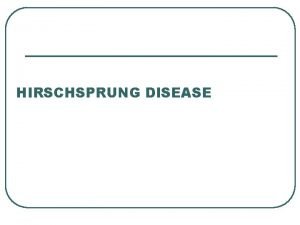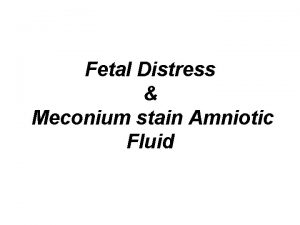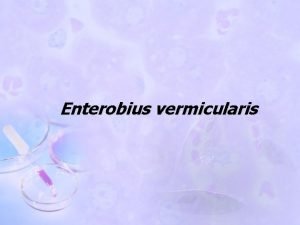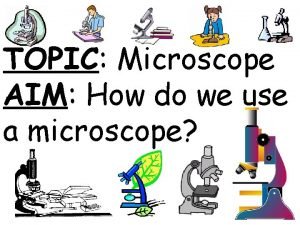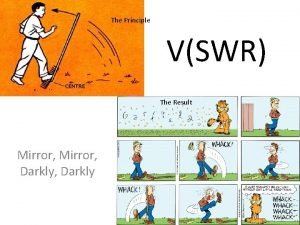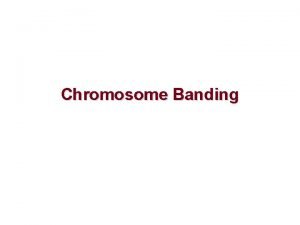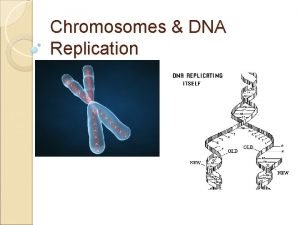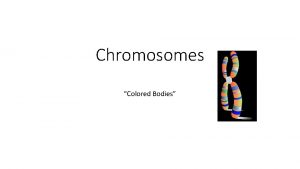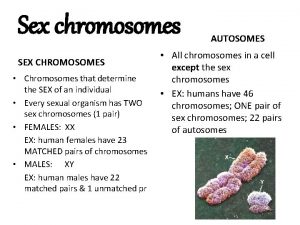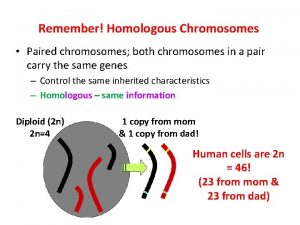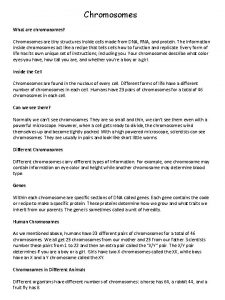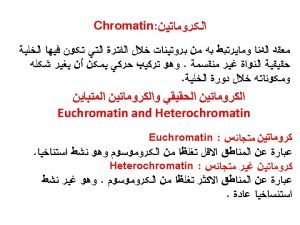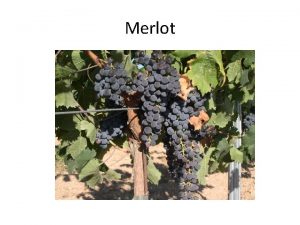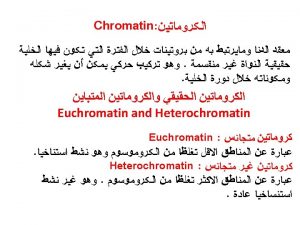CHROMOSOMES CHROMOSOMES The chromosomes are darkly stained small








































- Slides: 40

CHROMOSOMES

CHROMOSOMES • The chromosomes are darkly stained small bodies present in the nucleus and determine the mechanism of inheritance • Chromosomes are the physical structures which act as messenger of heredity. • After specific staining, it can be clearly seen during mitotic cell division during the metaphase.

Contd…. . • In all eukaryotic organisms including fishes, the DNA molecules in the nucleus are combined into proteins, mainly histones, to make chromosomes. • Genes are located on structures called “chromosomes”, which are located in the nucleus of every cell.

Diploid chromosome • The chromosome number in the cells of the body is normally made up of two sets, one of maternal (female) and one of paternal (male) origin, • is denoted by 2 n

Haploid chromosome • A single set of chromosomes found in a mature egg or in a spermatozoa is known as a haploid set is denoted by “n”. • A haploid set of chromosome is called genome. • When more than two sets of chromosomes occur in cells, the condition is termed polyploidy.

Structure of a chromosome • The material of chromosomes is called chromatin. • It contains euchromatin which stains but lightly and heterochromatin which stains darkly. • Euchromatin is believed to contain the genes in a linear array like beads on a string

Contd…. . • Heterochromatin is mostly made up of highly repeated simple sequences of DNA, satellite DNA • Heterochromatin is usually found near the centromere and on the ends of each chromosome.

Chromosome classification by centromeric position • • Metacentric Sub- metacentric Sub- telocentric Acrocentric or telocentric

Metacentric • Centromere is located approximately at the centre of the chromosome. • Their arms are approximately equal and they appear U or V shape during movement. Sub- metacentric • When the centromere lies a little distance away from the middle of the chromosomes may be called sub-metacentric.

Sub- telocentric • Centromere is located at sub-terminal position of the chromosome. • One arm is much longer than the other. • They appear J or L-shaped during movement. Acrocentric or telocentric • Centromere is located at the end (terminal) of the chromosome. • This is the most common karyotypes among fish species, and also it is found in a variety of distantly related fish taxa.

• Each chromosome contain two identical parallel structures or chromatids • Centromere or kinetochore divides the chromosomes in to two parts. • The position of centromere varies from chromosome to chromosome • The chromosomal ends are known as telomeres

Chromosome classification by centromeric position Type Centromeric position Symbol Centromeric index (range) Metacentric Nearly median m 46 -49 Submetacentric Submedian sm 26 -49 Acrocentric Subterminal st 15 -30 Telocentric Terminal t <15

• The portions of the chromosomes on their side of the centromere are called as the chromosome arms • The total number of chromosome arms in a karyotype is called as fundamental arm number (FN).

Centromeric index • The length of the shorter of the two chromosome arms multiplied by 100 and divided by the length of the whole chromosome and expressed as percentage.

Arm ratio • The length of the longer arm of the chromosome divided by the length of the shorter arm. It is always greater than 1. • It is an alternative method to centromeric index for describing the position of the centromere and the relative lengths of two arms.

Relative length • The length of the whole chromosome multiplied by 100 and divided by the total length of all the chromosomes in the haploid set including one being measured and expressed as a percentage.

Karyotypes • The complete set of chromosomes arranged according to their size • Karyotype of different species differ in size, shape, and number of chromosomes. • Within a species, the males and females may have minor dissimilarity in the karyotypes. • Pair of chromosomes which are very much similar are called as autosomes.

Fish chromosomes • The work on fish chromosomes began with the studies of Retziat (1890) and Katschenko (1890). • A revolution in the fish chromosome cytology took place when pre-treatment with colchicine coupled with squashing (Roberts, 1964) and the flame–drying method (Denton and Howell, 1969) were made.

• The first investigations of chromosomes were made by means of histological sections in the late nineteenth century • Then, squash techniques were performed which permitted a more accurate count of chromosome number. • the air-drying technique combined with colchicine and hypotonic treatment greatly increased our knowledge not only of chromosome number, but also of chromosome morphology.

Species chromosome numbers Catla, Rohu, Mrigal, Magur 50 Grass carp, Silver carp 48 Common carp, gold fish 104 H. fossilis 56 O. mossambicus, O. niloticus 44 C. Striatus C. gachua C. punctatus 40 78 32 M. rosenbergii 118 Penaeus monodon 88

Karyotyping • Pairing of the chromosomes according to their size and morphology, then became feasible. • Recent development of new differential staining techniques has allowed the characteristic banding of chromosomes that have led to a better understanding of the fine characterization of individual chromosomes.

The diploid (2 n) chromosome number of fishes • • Catla, rohu, mrigal grass carp and silver carp common carp, gold fish Tiger barb (Puntius tetrazona) Tor khudree Clarias batrachus Heteropnuestes fossilis -50 -48 -104 -48 -100 -50 - 56

Chromosomes of female Tilapia

Chromosome of C. batrachus

Sex chromosomes in fishes • Chromosomes that usually determine an individual’s sex and the pairs are often morphologically different in the two sexes. • Autosomes are the other pairs of chromosomes and are morphologically the same in males and females.

• Male heterogamety, that is XX♀-XY♂ sex chromosomes, is more prevalent among fishes than the female heterogamety (ZZ♂ -ZW♀). • Male heterogamety, is found in some deepwater fishes and female heterogamety in several species of catfishes.

Contd…. . • The sex chromosomes in lake trout (Salvelinus namaycush) could be detected by banding techniques • The X and Y chromosomes in this species are distinguishable by the prominent Cband on the X-chromosomes, which is much reduced in case of the Ychromosomes.

Polyploidy in fishes • Polyploid forms are found naturally in six different orders of fishes: • Acipenseriformes, Salmoniformes, Cypriniformes, Siluriformes, Poecilloformes and in one species of Perciformes. • Tetraploid fishes are the most common among the polyploid forms.

Contd…. . • Three species of cyprinids, the barb (Barbus barbus), the carp (Cyprinus carpio), and the goldfish (Carassius auratus) appear to be tetraploid • The yellow fish species of the genus Barbus (Cyprinidae) are hexaploids

Genetic significance of chromosomes • The chromosomes are considered as the organs of heredity because of the following reasons • They form the only link between two generations • A diploid chromosome set consists of two morphologically similar (except the X and Y sex chromosomes) sets, one is derived from the mother and another from the father at fertilization.

• The genetic material, DNA or RNA is localized in the chromosome and its contents are relatively constant from one generation to the next. • The chromosomes maintain and replicate the genetic informations contained in their DNA molecule.

MEIOTIC DIVISION • Meiosis is the process during which the primary gametocytes develop into eggs or sperm. • Meiosis consists of two cell divisions. • The first meiotic division is called the “reduction division” and the second is called the “equational division”

Crossing over • Crossing over is one of the most important biological processes, because it greatly increases genetic variability. • Crossing over tends to occur at particular locations along each chromosome. • Genes located near the centromere cross over less frequently than those further away

Equational division • The second meiotic division is called the “equational division”. • the replicated homologues (sister chromatids) in each secondary gametocyte separate and are parceled into either two sperm cells or into the egg and second polar body

Development of gene mapping methods and their application to fish species • The vast majority of mapped genes can be assigned to one of four classes: • Genes producing inherited diseases or defects. • Genes producing “mutant” phenotypes, though not necessarily affecting viability

Contd…. . • Genes producing distinctive colour patterns, and • Biochemical loci, coding for enzyme and other proteins. • In the first three classes, establishment of homology between species is usually difficult.

Chromosome banding • Chromosome banding can aid chromosome identification and gives additional information about the underlying organization of the chromosome. • G-banding and R-banding give a series of light and dark bands along the length of the chromosome. • C-banding produces dark bands in the region where the chromatin is more compacted (heterochromatin).

Somatic cell hybrids • This is the gene mapping method, which has produced a quantum expansion in gene map assignments • The power of this method lies in the use of cells from distantly related species.

In situ hybridization method • The most recently developed method of gene mapping with general utility is the mapping of genes to chromosomes by hybridizing DNA • Fluorescent in situ hybridization (FISH) has been used to physically localise some repeated non-coding DNA sequences like telomeric sequences, microsatellites and minisatellites on chromosomes.

Uses of linkage maps • Detailed linkage maps allow the identification of the types of chromosomal rearrangements • can be used to detect the number and location of other genes. • Genes involved in the inheritance of polygenic characters could be possibly identified by linkage to mapped markers.
 Manifistation
Manifistation Insidan region jh
Insidan region jh Anatomy chapter 3 cells and tissues
Anatomy chapter 3 cells and tissues Chagall stained glass chicago
Chagall stained glass chicago Profaners of this neighbour-stained steel
Profaners of this neighbour-stained steel Meconium grade 1 2 3
Meconium grade 1 2 3 Nih swab slideshare
Nih swab slideshare Blood stained into foreign dust
Blood stained into foreign dust Stained cheek cell
Stained cheek cell Chapter 29 marching toward war
Chapter 29 marching toward war Vẽ hình chiếu đứng bằng cạnh của vật thể
Vẽ hình chiếu đứng bằng cạnh của vật thể ưu thế lai là gì
ưu thế lai là gì độ dài liên kết
độ dài liên kết Chó sói
Chó sói Các môn thể thao bắt đầu bằng tiếng chạy
Các môn thể thao bắt đầu bằng tiếng chạy điện thế nghỉ
điện thế nghỉ Từ ngữ thể hiện lòng nhân hậu
Từ ngữ thể hiện lòng nhân hậu Một số thể thơ truyền thống
Một số thể thơ truyền thống Nguyên nhân của sự mỏi cơ sinh 8
Nguyên nhân của sự mỏi cơ sinh 8 Trời xanh đây là của chúng ta thể thơ
Trời xanh đây là của chúng ta thể thơ Slidetodoc
Slidetodoc Số nguyên là gì
Số nguyên là gì Tia chieu sa te
Tia chieu sa te Hổ sinh sản vào mùa nào
Hổ sinh sản vào mùa nào Các châu lục và đại dương trên thế giới
Các châu lục và đại dương trên thế giới Thế nào là hệ số cao nhất
Thế nào là hệ số cao nhất Tư thế ngồi viết
Tư thế ngồi viết Thế nào là mạng điện lắp đặt kiểu nổi
Thế nào là mạng điện lắp đặt kiểu nổi Cái miệng nó xinh thế chỉ nói điều hay thôi
Cái miệng nó xinh thế chỉ nói điều hay thôi đặc điểm cơ thể của người tối cổ
đặc điểm cơ thể của người tối cổ Mật thư tọa độ 5x5
Mật thư tọa độ 5x5 Bổ thể
Bổ thể Chụp phim tư thế worms-breton
Chụp phim tư thế worms-breton Tư thế ngồi viết
Tư thế ngồi viết Thẻ vin
Thẻ vin Thể thơ truyền thống
Thể thơ truyền thống Sự nuôi và dạy con của hươu
Sự nuôi và dạy con của hươu Các châu lục và đại dương trên thế giới
Các châu lục và đại dương trên thế giới Diễn thế sinh thái là
Diễn thế sinh thái là Giọng cùng tên là
Giọng cùng tên là Thiếu nhi thế giới liên hoan
Thiếu nhi thế giới liên hoan
